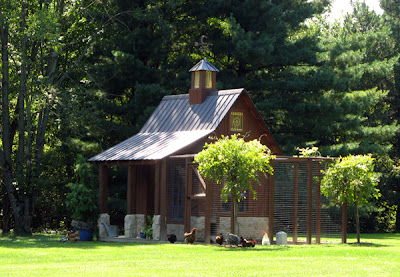We drove down and around some rural roads this afternoon, not unlike those of our home territory in the northwest part of the state. Except that there were hills. The locals wouldn't call them that, I'm sure, but they're more than we ever see out our back door and they roll just enough to add some character to the countryside.


A short while later, the Master Gardeners arrived and our visit officially began with Tracy giving a little history of how Hiddenhaven gardens came to be and what she does to create their beauty. Maintenance of the gardens is taken care of by Tracy and her husband, with help from friends on occasion, when things are especially busy, like during spring planting.
Tracy also explained how cutting back perennials can manipulate both their size and bloom time. I've done that with a couple of my own plants the last two summers, but I'll be much more bold with my pruners now that I know it's 'okay.'

One thing that stood out for me, the nearly novice gardener, was her use of annuals mixed in with the established perennials. Many of the gardens I've visited in the last three summers have made use of annuals and perennials together, of course, but most have tended to keep the two somewhat separate. If they are mixed in, there is a general boundary between the two, whether it be by spacing or by container. In these gardens, the annuals grew right alongside the perennials, grasses, shrubs and trees, as if they'd been there from the beginning of time, not merely since the middle of May.

A just-right-sized pond lies behind the house, with a meadow beyond, which plays host to many butterflies, both real and one very large stationary one. A tree house was the launching pad for a zip line that ran across the pond - all sorts of fun, everywhere you looked!
As the tour reached an end, Tracy had both of her books available for purchase and for signing:

This was a rare and appreciated opportunity to glean golden nuggets of practical advice from someone well-respected in the horticulture world and who was more than willing to share her expertise with us on a nearly-perfect September afternoon.




* Clicking on a photo will bring up a larger version *
*~*~*~*~*~*~*~*~*~*~*~*~*~*~*~*~*~*~*~*~*~*~*~*~*~*
Tracy DiSabato-Aust has over thirty years in the horticulture field. She obtained her B.S. and M.S. degree in Horticulture from The Ohio State University and has achieved international acclaim as a garden designer and speaker. She has worked with Longwood Gardens in the U.S., Montreal Botanical Garden in Canada, the Kalmthout Arboretum in Belgium, and Knightshayes Court in England.
Her first book, The Well-Tended Perennial Garden, has become the biggest selling book in Timber Press' publishing history. Tracy has contributed or been featured in articles in many magazines, including Fine Gardening (she is a contributing editor), Horticulture, Country Gardens, Garden Gate, Organic Gardening, Midwest Living, American Nurseryman, Real Simple, and Garden Design.When she isn't in the garden or on the lecture circuit, she is training and competing as a triathlete.









No comments:
Post a Comment